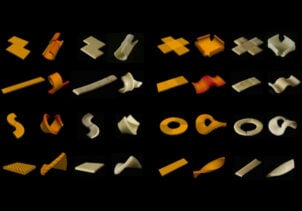Like pasta, the pursuit of global environmental sustainability takes many shapes. In a paper titled “Morphing Pasta and Beyond” published as the cover story in the May 2021 issues of Science Advances, researchers found a way to redesign noodles as flat structures that transform into three-dimensional shapes when cooked. Considering humanity’s appetite, it is a breakthrough that could move us toward a green future.
After it is cooked, the noodles look and taste like traditional pasta, but the flat redesigned noodles can be fit into more compact packaging. Smaller packages requiring less material would reduce waste and save space during transportation. Moreover, these shape-shifting carbs could lead to lower carbon emissions.
“Cooking pasta takes energy. This method can shorten the cooking time and that could also contribute to sustainability,” said mechanical and aerospace engineering Professor Teng Zhang who was a co-author of the study.
 The project has been a long-term collaboration between Zhang and Lining Yao, Director of the Morphing Matter Lab at Carnegie Mellon University (CMU), other researchers at CMU and Zhejiang University. To achieve morphing, grooves are strategically pressed into the surface of smooth, flat dough. In boiling water, the modified grooved side of the dough expands less than the smooth side thereby morphing the dough into more familiar contorted and tubular noodle shapes.
The project has been a long-term collaboration between Zhang and Lining Yao, Director of the Morphing Matter Lab at Carnegie Mellon University (CMU), other researchers at CMU and Zhejiang University. To achieve morphing, grooves are strategically pressed into the surface of smooth, flat dough. In boiling water, the modified grooved side of the dough expands less than the smooth side thereby morphing the dough into more familiar contorted and tubular noodle shapes.
Yao’s team learned grooves in the pasta would be an effective way to control the shape morphing, but initially they could not explain why. Zhang developed a computer model that explained why altering the surface texture would work.
“The final product can have an impact on sustainability, and to achieve this morphing it is an excellent mechanics problem,” said Zhang. “The modeling and simulation of pasta morphing was very challenging. Sometimes you would run a simulation and the simulation would just stop. It took us a long time to find the right platform and the right code to set up the model to get a result.”
Zhang’s model uncovered the working mechanism of the research team’s grooved-based approach, which could be a practical solution for the food industry. The next challenge from a modeling standpoint will be to develop a more complex and accurate model that will look at how production of the pasta and cooking technique influence the material structure.
“Now we want to improve the accuracy of the model. How the manufacturing process and the cooking process will modify the material property,” said Zhang. “We want to include the whole process in the modeling platform.”
Zhang’s research was funded by the National Science Foundation.
– by Christopher Barbera
